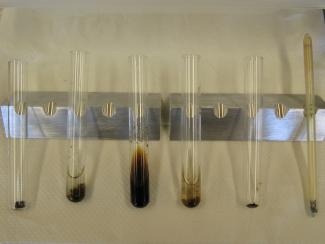
Most samples require some kind of pretreatment
Pretreatments are used to eliminate sources of contamination from a sample, or to isolate a particular fraction of carbon from within the sample matrix. Lack of pretreatment will result in a date that is either too young or too old.
Common treatment for wood, charcoal, scat, and textiles
These samples typically undergo pretreatment consisting of a series of acid/alkali/acid/ heated washes and final Nano pure water rinses. The goal of the pretreatment is to remove any soluble organics that may have been deposited on the sample over time and which are not representative of the material of interest.
The first acid wash (HCL) removes inorganic carbon and acid soluble organic carbon. This is followed by a series of heated alkali washes (NaOH) to remove base soluble organic acids followed by a second heated acid wash to neutralize the solution. The samples are then rinsed of the acid residue with Nano pure water before drying.
Preparing wood for radiocarbon analysis can require additional treatment depending on the tree species and the research question. Please consult Southon and Magana, 2010, for additional information.
A general acid/base/acid protocol is downloadable below.
This paper outlines the common pretreatment methods employed by the Oxford Radiocarbon Accelerator Unit's lab.
Common treatments for soils, sediments and peat
Mineral soils may contain inorganic carbon in the form of carbonate minerals. Generally, for most studies of terrestrial carbon cycling, these carbonates are removed prior to graphitization. Acid fumigation is used to remove carbonates without loss of organic carbon. The method is given in Harris et al., 2001.
Many research groups discourage the dating of bulk soils and sediments since these are heterogeneous composites of materials that may vary widely in radiocarbon abundance and molecular composition. A myriad of techniques have been developed in an attempt to partition bulk soils into fractions of differing radiocarbon abundance and composition. Take a look at the radiocarbon in soils page for more information.
For radiocarbon dating of peat and organic soils, some researchers date the bulk material. More commonly, plant macrofossils are isolated from the bulk material and pretreated with acid and base washes prior to radiocarbon measurement. A number of studies have been conducted to compare bulk dating and macrofossil dating with a variety of conclusions being drawn as to whether bulk material is representative of the time of deposition or not (Holmquist et al., 2015; Tornqvist, 1992; Shore et al., 1995).
Common treatments for carbonate samples (shells, forams, corals)
Carbonate samples are subjected to heavy (in the case of shells and large coral samples) or light (forams, delicate shells) acid rinses in order to etch away any secondary carbonate contamination. Carbonates are acidified in evacuated blood vials in order to oxidize their carbon instead of following the standard combustion protocol used for organic carbon samples.
Common treatments for bones and horns
Using 0.25 N to 0.5 N HCl, depending on the sample integrity, bone or antler samples are first decalcified. The decalcification takes place in a cold environment. (standard lab refrigerator). This process may take up to one week. The sample is then rinsed and washed with a weaker acid (0.01 N HCl) and placed on a heat block for 16 hours to unwind the proteins. The solution containing the collagen is then filtered and lyophilized prior to combustion.
